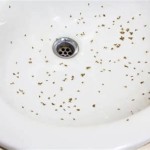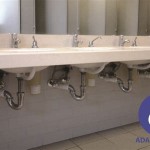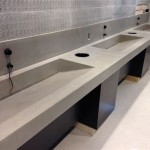Bathroom Sink Not Draining: Air Lock Troubleshooting
A bathroom sink that refuses to drain can be a frustrating inconvenience. While a clogged drain is a common culprit, a less familiar yet equally troublesome issue is an air lock. Air locks occur when a pocket of trapped air prevents water from flowing through the drainpipe, effectively blocking the drainage process. This article will delve into the intricacies of air locks and provide a comprehensive guide to troubleshooting and resolving this plumbing problem.
Understanding Air Locks
An air lock forms when air gets trapped within the drainpipe, usually at a bend or a high point. This trapped air creates a barrier, preventing the water from flowing through the pipe. The presence of an air lock can be identified by the following characteristic signs:
- Slow drainage: Water drains slowly from the sink, often pooling at the bottom.
- Gurgling noises: A gurgling sound may be heard coming from the drain as the water tries to pass through the air lock.
- Water level fluctuations: The water level in the sink may rise and fall erratically as the air lock intermittently releases and traps air.
Air locks can occur due to a variety of factors, including:
- Recent plumbing work: Any alterations to the plumbing system, such as installing new fixtures or repairing pipes, can introduce air into the system, leading to air lock formation.
- Vacuum created by water flow: When water flows through the drainpipe, it can create a vacuum that pulls air into the system. If the air cannot escape, it can become trapped, forming an air lock.
- Temperature fluctuations: Changes in water temperature can cause air to expand and contract in the pipes, creating a pocket of trapped air.
- Pipe configuration: A drainpipe with an unusual configuration or a bend that traps air can be prone to air locks.
Troubleshooting Air Locks
Resolving an air lock typically involves removing the trapped air from the drainpipe. Here are some effective methods:
1. Plunging the Drain
Though often associated with clogged drains, plunging can also help dislodge air locks. By creating pressure fluctuations in the drainpipe, plunging can sometimes force the trapped air out. Place the plunger over the drain opening, ensuring a tight seal, and plunge up and down forcefully. You may hear a gurgling sound as the air is released. Repeat this process several times until the water drains freely.
2. Running the Faucet
In some cases, simply running the faucet for an extended period can help resolve the air lock. By creating a steady flow of water, the pressure can dislodge the trapped air. Run the faucet for a few minutes, allowing the water to flow freely, and observe if the drainage improves. If the issue persists, try running the faucet while simultaneously plunging the drain.
3. Using a Wet/Dry Vacuum
For stubborn air locks, a wet/dry vacuum can be employed to remove the trapped air. Carefully insert the vacuum hose into the drain opening, ensuring it reaches the point where the air is trapped. Start the vacuum on low setting and observe the air being sucked out. This method can be particularly effective when the air lock is located at a bend or a high point in the drainpipe.
4. Opening an Air Vent
Some plumbing systems have an air vent installed to allow air to escape and prevent air lock formation. Locate the air vent, typically a small, open pipe near the drain, and ensure it is unobstructed. If the vent is blocked or missing, consider installing one to address potential air lock issues.
Preventative Measures
Once the air lock is resolved, there are preventative measures you can take to minimize the risk of it recurring:
- Avoid sudden temperature changes: When running hot water after a period of cold water use, allow the water to flow for a few seconds before using the sink, allowing the pipes to adjust to the temperature change.
- Inspect and clear air vents: Regularly check the air vents for any blockages and clear them as necessary. Ensure the vent is free of debris and obstructions.
- Check for leaks: A leaking faucet or drain can create a vacuum that can pull air into the system. Address any leaks promptly.
- Maintain proper drainpipe slope: Ensure the drainpipe is properly sloped to allow for water to flow freely and prevent air from being trapped at high points.
Air locks can be a persistent plumbing problem that can cause frustration and inconvenience. Understanding the cause, employing the right troubleshooting methods, and implementing preventative measures can help prevent and address this issue effectively. If you have any doubts, it's always best to consult a professional plumber for guidance and assistance.

Experiencing Airlock In Your Plumbing System Robinson

How To Clear A Clogged Drain Reviews By Wirecutter

Experiencing Airlock In Your Plumbing System Robinson

How To Fix Gurgling Bathroom Sink Inside Out Property Inspectors

How To Fix A Slow Draining Sink Phyxter Home Services

Dealing With Airlock In Pipes Causes Symptoms And Solutions
I Closed My Sink Drain Stopper And Now It Won T Open Again Is There Any Way That Can Repair This Without Hiring A Plumber Quora
What Is The Issue If P Trap Clean But Sink Won T Drain Quora

Draining Plumbing With Compressed Air

Signs Of An Air Lock In Your Plumbing System Rooter Hero
Related Posts






